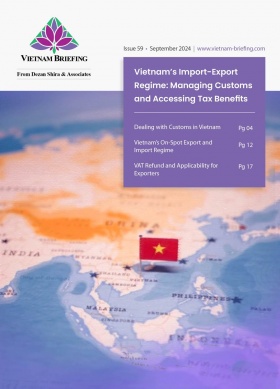Major Upgrade of Vietnam’s Port System Under Decision No. 442/QD-TTg
Vietnam aims to upgrade its port system by 2030, targeting an annual cargo capacity of 1.25 to 1.5 billion tons as outlined in Decision No. 442/QD-TTg. This initiative addresses current capacity limitations and emphasizes modernization, infrastructure improvements, and environmental sustainability to enhance global trade competitiveness.
As part of an ambitious strategy to modernize its maritime infrastructure, Vietnam is set to significantly upgrade its port system by 2030, aiming to accommodate an annual cargo capacity of between 1.25 and 1.5 billion tons.
This initiative was formalized in Decision No. 442/QD-TTg (hereinafter, Decision 442), signed by Deputy Prime Minister Tran Hong Ha, which amends the existing master plan for port development from 2021 to 2030, with a long-term vision extending to 2050.
In this article, we explore the current state of Vietnam’s port system, assess the challenges and limitations it faces, and examine the government’s initiatives to enhance port infrastructure as outlined in Decision 442.
Current state of Vietnam’s port system
Vietnam’s port system plays a vital role in facilitating the efficient movement of goods, connecting the nation to global markets and supporting its export-driven economy. The system is categorized into four classes:
- Special-class ports;
- Class I ports;
- Class II; and
- Class III ports.
Each category is designed to meet specific functions. Special-class ports, such as Lach Huyen in Hai Phong and Cai Mep in Ba Ria–Vung Tau, serve as crucial international gateways, equipped to handle large-scale international trade.
Class I ports support significant national industrial zones, while Class II and III ports cater to regional and local economic needs, respectively.
However, despite these classifications and the strategic importance of these ports, the system currently struggles with capacity limitations, impacting its ability to accommodate the growing demands of modern shipping.
Assessment of challenges and limitations
With approximately 75 percent of freight and 90 percent of passenger traffic relying on road transport, Vietnam’s port system faces significant congestion challenges. This reliance leads to inefficiencies in the supply chain, resulting in higher transportation costs for exporters and limiting the competitiveness of Vietnamese goods in global markets. The need for enhanced port infrastructure is paramount to alleviate congestion and streamline the movement of goods.
Moreover, many of Vietnam’s ports are hindered by outdated infrastructure, which restricts their capacity to handle larger containerships effectively. This limitation not only affects the ports’ operational efficiency but also raises transportation costs, ultimately impacting the country’s economic ambitions.
Lastly, as the government focuses on expanding port capacities, environmental sustainability has also become a pressing concern. The Vietnam Maritime Administration is spearheading initiatives to ensure compliance with stringent environmental standards.
Government support to port infrastructure development in Vietnam
The Vietnamese government is prioritizing the acceleration of key transportation projects, including port infrastructure, to enhance national connectivity and support economic growth. At a recent meeting led by Prime Minister Pham Minh Chinh, significant emphasis was placed on the need for a concerted effort to mobilize resources effectively to meet ambitious development goals.
The Prime Minister outlined that the government is actively implementing 40 important national transportation projects, with a total of 92 components spread across various modes of transport: road, rail, and air. Among these, the development of port infrastructure plays a crucial role in facilitating trade and logistics efficiency.
To address key challenges in port infrastructure development, the Prime Minister called for improved coordination among local authorities, investors, and contractors, particularly in expediting land clearance and approving construction materials. Specific directives were given to localities to remove bottlenecks that hinder progress, ensuring timely completion of crucial projects. For example, the Long Thanh International Airport Project and urban rail initiatives are linked to enhancing access to port facilities, showcasing an integrated approach to transportation planning.
Key features of Decision 442
Decision 442 represents a significant shift in Vietnam’s strategic approach to its seaport system, emphasizing both modernization and expansion as key priorities. The amendments aim to enhance the capacity of the seaport system to meet the increasing demands of domestic and international trade.
Notably, the updated capacity targets are ambitious, with expectations set between 1,249 and 1,494 million tons of cargo handling by 2030. This includes a substantial increase in container throughput, projected to reach between 46.3 and 54.3 million TEUs. Such goals are crucial for supporting the growing needs of import and export activities across regions, as well as facilitating the transit of goods for neighboring countries.
In conjunction with these capacity increases, specific ports have been identified for targeted upgrades. International gateway ports, such as Lach Huyen Port in Hai Phong, Cai Mep – Thi Vai Port in Ba Ria – Vung Tau, and the newly planned Can Gio International Transit Port in Ho Chi Minh City, are central to this modernization effort. The focus on these ports highlights their strategic importance in enhancing Vietnam’s competitive position in global trade networks, as they will serve as crucial hubs for larger-scale international commerce.
The decision also underscores the need for improved infrastructure to support these enhancements, reflecting a comprehensive approach to port development.
Goals set for the 2021-2030 Period
The goals set forth for the period from 2021 to 2030 are ambitious and strategically aligned with Vietnam’s broader economic objectives.
One of the primary aims is to significantly increase the capacity of the seaport system, with projections indicating that cargo throughput for Group 1 ports could reach between 322 and 384 million tons. This substantial capacity enhancement is not merely about numbers; it represents Vietnam’s commitment to positioning itself as a robust player in the global logistics arena. Alongside this, container handling is anticipated to grow to between 13 and 16 million TEUs, further solidifying the nation’s logistical capabilities.
Infrastructure improvements are equally vital to these goals. The decision outlines an investment demand of approximately VND313,000 billion (US$12.74 million) for port infrastructure development by 2030.
This investment is intended to be mobilized primarily from non-budgetary sources and private capital, reflecting a shift towards leveraging private sector involvement in public infrastructure projects.
By prioritizing modernization of existing facilities and the construction of new ones, the plan aims to create a more efficient and resilient seaport system capable of adapting to the dynamic needs of global trade.
Long-term vision through 2050
Looking beyond 2030, the long-term vision outlined in Decision 442 extends to 2050 and emphasizes sustainable economic growth through a robust seaport system. The strategic goals established for this period include achieving an average annual growth rate of approximately 4.2 percent to 4.8 percent for cargo handling and 1.2 percent to 1.3 percent for passenger transport. Such ambitious growth targets are indicative of Vietnam’s aspirations to maintain a competitive edge in an increasingly globalized economy.
Moreover, the decision highlights a commitment to environmental sustainability, aligning with global trends towards greener practices. Investments will focus not only on enhancing operational capacities but also on reducing the carbon footprint associated with port activities.
For instance, Decision 442 highlights the importance of responsible waterway management and coastal protection as integral components of the seaport system. This includes establishing protocols for oil spill response, waste disposal, and the management of ballast water to prevent the introduction of invasive species.
This commitment to ecofriendly technologies and renewable energy sources is crucial for ensuring that Vietnam’s seaport system can meet the demands of future trade while adhering to global environmental standards.
Economic and strategic importance of Decision 422
All in all, Decision 422 represents a pivotal step for Vietnam in enhancing its economic and strategic landscape. By focusing on improving trade and logistics capabilities, the decision facilitates smoother exports and imports, thereby reinforcing Vietnam’s position within global supply chains.
Furthermore, it opens the door to increased foreign investment opportunities, signaling to investors that Vietnam is committed to modernizing its infrastructure and practices.
About Us
Vietnam Briefing is published by Asia Briefing, a subsidiary of Dezan Shira & Associates. We produce material for foreign investors throughout Asia, including ASEAN, China, and India. For editorial matters, contact us here and for a complimentary subscription to our products, please click here. For assistance with investments into Vietnam, please contact us at vietnam@dezshira.com or visit us at www.dezshira.com.
Dezan Shira & Associates assists foreign investors throughout Asia from offices across the world, including in Hanoi, Ho Chi Minh City, and Da Nang. We also maintain offices or have alliance partners assisting foreign investors in China, Hong Kong SAR, Dubai (UAE), Indonesia, Singapore, Philippines, Malaysia, Thailand, Bangladesh, Italy, Germany, the United States, and Australia.
- Previous Article IMF Projects 6.1% Growth for 2024 for Vietnam Amid Challenges
- Next Article Proposed Vietnam Industrial Classification System Prioritizes Green Economy








